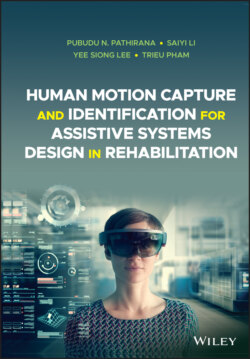Читать книгу Human Motion Capture and Identification for Assistive Systems Design in Rehabilitation - Pubudu N. Pathirana - Страница 14
Lower motor neurone disorders – spinal muscular atrophies
ОглавлениеLower motor neurones are located in either the anterior grey column, anterior nerve roots (spinal lower motor neruones) or the cranial nerve nuclei of the brain stem and cranial nerves with a motor function (cranial nerve lower motor neurones) [1]. All voluntary movement relies on spinal lower motor neurones, which innervate skeletal muscle fibres and act as a link between the upper motor neurons and muscles [2, 3]. Cranial nerve lower motor neurones control movements of the eyes and tongue, and contribute to chewing, swallowing and vocalisation [4]. Damage to the lower motor neurone can lead to flaccid paralysis.
Table 1.2 Examples of musculoskeletal injuries in joints of the lower extremities.
| Hip | Knee | Ankle | |
|---|---|---|---|
| Movements | Flexion, extension, abduction, adduction, internal and external rotation [149] | There are two ways to describe the degree of freedom (DOF) in a knee. One is with two DOFs (flexion‐extension and axial rotation) [234] and the other is with six DOFs (flexion‐extension, varus‐valgus, internal‐external rotation and mediolateral, anteroposterior and superoinferior translation around mediolateral, anteroposterior and superoinferior axis) [122]. | Extension, flexion, valgus and varus [301] |
| Inj1 | Hamstring strain | Patellofemoral pain syndrome | Achilles tendonitis |
| Description | It usually associated with lower extremity activities, like football, soccer, dancing and so on, while this condition occurs in different phases of motions in various types of activity [149]. | It is an anterior knee pain and mainly resulted from “aberrant motion of the patella in the trochlear groove” [123]. | The physical findings of this condition include soft tissue swelling, local tenderness and sometimes crepitus [256]. |
| ST | [326] | [214] | [222] |
| Inj2 | Groin pain | Anterior cruciate ligament (ACL) injury | Lateral sprain |
| Description | It contributes 2–5% of all sport injuries [243]. Vincent et al. [243] also mentioned that the diagnosis of this pain is hard because of its complex anatomy in the affected region, as well as the coexistence of multiple injuries. | The causes are in two major categories, including non‐contact (usually resulted from sudden deceleration before changing direction or a landing motion) and contact (valgus collapse) [45]. | It can be deemed as the most common injury in ankles [114], which is usually cause by inversion of the foot [114]. |
| ST | [302] | [74] | [103] |
